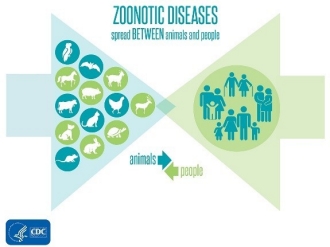About
Page last updated 09/19/2023.
Animals can sometimes carry harmful germs that can spread to people and cause illness – these are known as zoonotic diseases, or zoonoses. Zoonotic diseases are very common in the United States and around the world. The Centers for Disease Control and Prevention (CDC) estimates that more than 6 out of every 10 known infectious diseases in people can be spread from animals, and 3 out every 4 new or emerging infectious diseases in people come from animals.
Established in May 2023, the One Health Epidemiology Program (OHEP) is dedicated to the surveillance, investigation, response, and prevention of zoonotic disease outbreaks in San Diego County.
What Does OHEP Do?
- Respond to and investigate reports of zoonotic disease in San Diego County.
- Develop local reporting guidelines for zoonotic diseases in animals.
- Develop disease surveillance of domestic animal species and wildlife.
- Develop One Health Epidemiology Network with veterinarians and physicians practicing in San Diego County.
- Provide outreach and education to human and veterinary health care communities as well as the public regarding One Health and zoonotic disease transmission, current cases/outbreaks, and prevention efforts.
What are Zoonotic Diseases (Zoonoses)?
Zoonotic diseases are caused by germs like viruses, bacteria, parasites, and fungi that spread between animals and people. These germs can cause many different types of illnesses in people and animals, ranging from mild to serious illness, and even death.
What Zoonotic Diseases are of Most Concern in the US?
According to the Centers for Disease Control and Prevention (CDC), the following are priority zoonotic diseases in the United States:
- Brucellosis
- Lyme Disease
- Plague
- Rabies
- Salmonellosis
- West Nile Virus
- Zoonotic Influenza
OHEP is eager to connect with local veterinarians, human healthcare professionals, and researchers who are interested in collaborating to develop our surveillance and reporting strategies and zoonotic disease investigation priorities.
How are Zoonotic Diseases Spread?
Common ways people can get infected with germs that can cause zoonotic diseases include:

Direct contact: Coming into contact with the saliva, blood, urine, mucous, or other bodily fluids of an infected animal. Examples include petting or touching animals, and bites or scratches.

Indirect Contact: Coming into contact with areas where animals live and roam, or objects or surfaces that have been contaminated with germs. Examples include aquarium tank water, pet habitats, chicken coops, barns, plants, and soil, as well as pet food and water dishes.

Vector-borne: Being bitten by a tick, or an insect like a mosquito or a flea.

Foodborne: Eating or drinking something unsafe, such as unpasteurized (raw) milk, undercooked meat or eggs, or raw fruits and vegetables that are contaminated with feces from an infected animal.

Waterborne: Drinking or coming in contact with water that has been contaminated with urine or feces from an infected animal.
How can you protect yourself and others from zoonotic diseases?
- Wash your hands right after being around animals, even if you did not touch the animals.
- Stay healthy around your pets and avoid bites and scratches from animals
- Prevent bites from mosquitoes, ticks, and fleas.
- Handle food – whether for yourself, your family, your pet, or other animals – safely.
- Respect the space of wildlife, oberserve them from a distance, and do not touch wildlife.
- Report a bat found in your home or yard.
For more information, contact the San
Diego One Health Epidemiology program through our contact
form, via
e-mail at phs.ohep.hhsa@sdcounty.ca.gov,
or call the Epidemiology Unit at (619) 692-8499.







